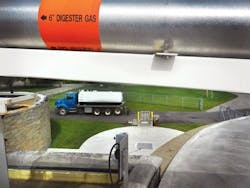The city of Stevens Point, Wis., owns and operates a municipal activated sludge wastewater treatment facility (WWTF) that processes an average of 2.9 million gal per day. The city’s staff works diligently to operate the facility as efficiently as possible in order to prevent unnecessary rate increases for their residential and industrial customers. Every aspect of the facility frequently is analyzed to identify opportunities that may improve its efficiency. When an opportunity is found, a cost analysis is reviewed prior to implementation to ensure sustainability. This scrutiny has led to the implementation of multiple successful projects, which have effectively lowered the facility’s electric usage by almost 25% from 2002 to 2011. Energy savings typically are achieved through equipment replacements and changes in technology. However, the entire staff views energy savings as a daily task, thus continual adjustments to the normal operations are implemented to reduce costs without sacrificing treatment performance.
During this period, an opportunity to maximize the facility’s intrinsic capacity was identified to boost tipping fee revenue. Starting in 2010, the city implemented a program to utilize the facility’s excess anaerobic digestion capacity by accepting trucked-in high-strength wastewater using existing infrastructure. This wastewater then are co-digested with other solids from the treatment process in the facility’s mesophilic anaerobic digesters to generate significantly more methane-laden biogas. The city took the next step toward maximum efficiency in 2012, when a 180-kW biogas-fueled combined heat and power (CHP) unit was commissioned. Since installation, the CHP unit has produced more than 90% of the electricity used at the WWTF, while capturing enough heat for the anaerobic digestion process, as well as multiple buildings.
The Rise of Craft Beer
The largest contributor of biochemical oxygen demand and total suspended solids loadings to the WWTF is the Stevens Point Brewery. The brewery has been in operation since 1857 and is the fifth-oldest continuously operated brewery in the U.S. Due to the recent popularity of craft-brewed beer, the brewery has doubled its production since 2010. While this increase has been good for the local economy, it also doubled the amount of wastewater that the brewery discharges to the WWTF. With no pretreatment system, the standard operating procedure for disposing of the high-strength wastewater from the brewing process was to drain the tanks onto the floor and hose the wastewater down the floor drain. It then flows to the WWTF via the collection system and was being treated with conventional activated sludge. This process was labor-intensive for the brewery and caused energy and organic slug loading issues at the WWTF.
In October 2014, the city of Stevens Point and the brewery worked cooperatively to break ground on a project that helped alleviate the wastewater loading problems caused by the brewery growth. This project provides the brewery with a way to pump the high-strength wastewater from its tanks directly to an 1,800-gal tank located on site. The wastewater is pumped from this holding tank through a force main to a new 40,000-gal high-strength wastewater equalization tank located at the WWTF. This equalization tank is used to take in all the trucked-in wastewater that is fed to the anaerobic digesters, along with the material from the brewery. The material that is added to this equalization tank has a variety of densities, which causes the mixture to stratify quickly. A pump-and-nozzle mixing system was installed as part of the project to keep the digester feed homogenous. The wastewater from the equalization tank then is metered continuously into the existing anaerobic digesters to prevent slug loadings and retain enough feed stock to supplement biogas production during periods of lower facility loading. This consistent feed produces quality digested biosolids and consistent methane content in the biogas.
Public-Private Partnership
Of the many challenges surmounted in this project, the most significant was the development of the public-private partnership. The partnership agreement resolved concerns of initial project funding, ongoing operation and maintenance costs, and access, while providing incentives to optimize the system. It was agreed that the two entities would evenly split the funding of the project and the brewery would own and maintain all of the pumps and piping up to the tank located in the facility. The city would be responsible for the high-strength wastewater tank located at the brewery and all of the equipment and piping downstream to the WWTF.
This new high-strength wastewater collection system allows the brewery to increase the productivity of its employees and tankage by streamlining its standard operating procedures. The wastewater it is able to divert from the normal collection system also could save more than $100,000 annually in sewer use surcharges. The city’s WWTF regained valuable loading capacity to allow for continued city growth and also solidified high-quality digester feed stock. Through teamwork and ingenuity, this opportunity became another successful project for everybody involved.
Download: Here


